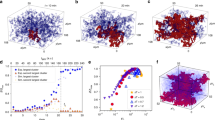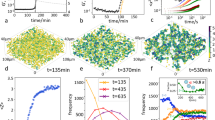Abstract
The gelation process has been explained in the framework of percolation models. Although the percolation models accurately predict the gelation behaviors above the overlap concentration of prepolymers (c*0), they do not predict the gelation behaviors below c*0. We measured the osmotic pressure during the gelation of a series of model polymer gels, namely, tetra-polyethylene glycol (PEG) gels. The osmotic pressure decreased during the gelation reaction and was constant after the sol–gel transition. These results suggest that the clusters grow and fill the system at the sol–gel transition point. As a result, the gels behaved as semidilute systems regardless of the initial polymer concentration. This representation of the sol–gel transition at the overlap condition of the critical clusters corresponds well to the aggregation process predictrion. These results will help better understanding of general percolation problems in the dilute regime.
This is a preview of subscription content, access via your institution
Access options
Subscribe to this journal
Receive 12 print issues and online access
$259.00 per year
only $21.58 per issue
Buy this article
- Purchase on Springer Link
- Instant access to full article PDF
Prices may be subject to local taxes which are calculated during checkout







Similar content being viewed by others
References
Last BJ, Thouless DJ. Percolation theory and electrical conductivity. Phys Rev Lett. 1971;27:1719–21.
Watson BP, Leath PL. Conductivity in the two-dimensional-site percolation problem. Phys Rev B. 1974;9:4893–6.
Southern BW, Young AP, Pfeuty P. Effects of percolation on spin glass order. J Phys C. 1979;12:683–94.
de Arcangelis L, Coniglio A, Peruggi F. Percolation transition in spin glasses. 1991. iopscience.iop.org.
Moore C, Newman MEJ. Epidemics and percolation in small-world networks. Phys Rev E. 2000;61:5678–82.
Ren J, Zhang L, Siegmund S. How inhomogeneous site percolation works on bethe lattices: theory and application. Sci Rep. 2016;6:22420.
Antonelli C. Localized knowledge percolation processes and information networks. J Evol Econ. 1996;6:281–95.
Duffie D, Manso G. Information percolation in large markets. Am Econ Rev. 2007. pubs.aeaweb.org.
Flory PJ. molecular size distribution in three dimensional polymers. I. Gelation1. J Am Chem Soc. 1941;63:3083–90.
Nakagawa H, Suzuki M, Hanabusa K. Physical gelation by amides derived from trans-1,2-diaminocyclohexane and their tetrasiloxane-based gelators. Polym J. 2017;49:439–47.
Takata K, Kawahara K, Yoshida Y, Kuzuya A, Ohya Y. Analysis of the sol-to-gel transition behavior of temperature-responsive injectable polymer systems by fluorescence resonance energy transfer. Polym J. 2017;49:677–84.
Izumi A, Shudo Y, Shibayama M. Network structure evolution of a hexamethylenetetramine-cured phenolic resin. Polym J. 2019;51:155–60.
Zhang P, Bin Y, Zhang R, Matsuo M. Average gap distance between adjacent conductive fillers in polyimide matrix calculated using impedance extrapolated to zero frequency in terms of a thermal fluctuation-induced tunneling effect. Polym J. 2017;49:839–50.
Wang J, Zhou Z, Zhang W, Garoni TM, Deng Y. Bond and site percolation in three dimensions. Phys Rev E. 2013;87:052107.
Xu X, Wang J, Lv J-P, Deng Y. Simultaneous analysis of three-dimensional percolation models. Front Phys. 2014;9:113–9.
Stauffer D, Coniglio A, Adam M. Gelation and critical phenomena. Adv Polym Sci. 1982;44:103–58.
Martin JE, Wilcoxon J, Adolf D. Critical exponents for the sol-gel transition. Phys Rev A. 1987;36:1803–10.
Katashima T, Sakurai H, Chung U-I, Sakai T. Dilution effect on the cluster growth near the gelation threshold. Nihon Reoroji Gakkaishi. 2019;47:61–66.
Takigawa T, Urayama K, Masuda T. Critical-behavior of the intrinsic-viscosity of poly(vinylalcohol) solutions near the gelation point. J Chem Phys. 1990;93:7310–3.
Zheng H, Zhang Q, Jiang K, Zhang H, Wang J. Critical behavior of viscosity for alginate solutions near the gelation threshold induced by cupric ions. J Chem Phys. 1996;105:7746–52.
Takigawa T, Urayama K, Masuda T. Critical-behavior of the specific viscosity of poly(vinyl alcohol) solutions near the gelation threshold. Chem Phys Lett. 1990;174:259–62.
Martin JE, Adolf D. The sol-gel transition in chemical gels. Annu Rev Phys Chem. 1991;42:311–39.
Nishi K, Noguchi H, Sakai T, Shibayama M. Rubber elasticity for percolation network consisting of Gaussian chains. J Chem Phys. 2015;143:184905.
Nishi K, Chijiishi M, Katsumoto Y, Nakao T, Fujii K, Chung U, et al. Rubber elasticity for incomplete polymer networks. J Chem Phys. 2012;137:224903.
Winter HH. In: Borsali R, Pecora R, editors. Structure and dynamics of polymer and colloidal systems. Netherlands: Springer; 2002. p. 439–70. https://doi.org/10.1007/978-94-010-0442-8_14.
Sakai T, Katashima T, Matsushita T, Chung U-I. Sol-gel transition behavior near critical concentration and connectivity. Polym J. 2016;48:629–34.
Shibayama M, Norisuye T. Gel formation analyses by dynamic light scattering. Bull Chem Soc Jpn. 2002;75:641–59.
Takeda M, Norisuye T, Shibayama M. Critical dynamics of cross-linked polymer chains near the gelation threshold. Macromolecules. 2000;33:2909–15.
Jokinen M, Györvary E, Rosenholm JB. Viscoelastic characterization of three different sol–gel derived silica gels. Colloids Surf A. 1998;141:205–16.
Winter H, Mours M. In: Neutron spin echo spectroscopy viscoelasticity rheology. Berlin, Heidelberg: Springer; 1997. 134, p. 165–234.
Miura T, Okumoto H, Ichijo H. Concentration dependence of the sol-gel transition point and the network formation of polymer gels. Phys Rev E. 1996;54:6596–602.
Takahashi M, Yokoyama K, Masuda T, Takigawa T. Dynamic viscoelasticity and critical exponents in sol-gel transition of an end-linking polymer. J Chem Phys. 1994;101:798–804.
Izuka A, Winter HH, Hashimoto T. Molecular weight dependence of viscoelasticity of polycaprolactone critical gels. Macromolecules. 1992;25:2422–8.
Adam M. Growth-process of polymers near the gelation threshold. Makromol Chem-M Symp. 1991;45:1–9.
Fang L, Brown W, Konak C. Dynamic light scattering study of the sol-gel transition. Macromolecules. 1991;24:6839–42.
Martin JE, Wilcoxon J, Odinek J. Decay of density fluctuations in gels. Phys Rev A. 1991;43:858–72.
Martin JE, Adolf D, Wilcoxon JP. Viscoelasticity near the sol-gel transition. Phys Rev A. 1989;39:1325–32.
Martin JE, Wilcoxon JP. Critical dynamics of the sol-gel transition. Phys Rev Lett. 1988;61:373–6.
Vicsek T. Fractal growth phenomena. World Scientific; 1992.
Sorensen CM, Chakrabarti A. The sol to gel transition in irreversible particulate systems. Soft Matter. 2011;7:2284–96.
Kolb M, Botet R, Jullien R. Scaling of kinetically growing clusters. Phys Rev Lett. 1983;51:1123–6.
Fry D, Sintes T, Chakrabarti A, Sorensen CM. Enhanced kinetics and free-volume universality in dense aggregating systems. Phys Rev Lett. 2002;89:148301.
Sakai T, Matsunaga T, Yamamoto Y, Ito C. Design and fabrication of a high-strength hydrogel with ideally homogeneous network structure from tetrahedron-like macromonomers. ACS Publ. 2008;41:5379–84.
Sakai T. Experimental verification of homogeneity in polymer gels. Polym J. 2014;46:517–23.
Sakai T. Gelation mechanism and mechanical properties of Tetra-PEG gel. React Funct Polym. 2013;73:898–903.
Yoshikawa Y, Sakumichi N, Chung U-I, Sakai T. Connectivity dependence of gelation and elasticity in AB-type polymerization: an experimental comparison of the dynamic process and stoichiometrically imbalanced mixing. Soft Matter. 2019;15:5017–25.
Horkay Ferenc, Ichiji Tasaki A, Basser PJ. Osmotic swelling of polyacrylate hydrogels in physiological salt solutions. Biomacromolecules. 2000;1:84–90.
Vink H. Precision measurements of osmotic pressure in concentrated polymer solutions. Eur Polym J. 1971;7:1411–9.
Xu X, Wang J, Lv J-P, Deng Y. Simultaneous analysis of three-dimensional percolation models. Front Phys. 2013;9:113–9.
Cloizeaux Des J, Noda I. Osmotic pressure of long polymers in good solvents at moderate concentrations: a comparison between experiments and theory. Macromolecules. 1982;15:1505–7.
Li X, Hirosawa K, Sakai T, Gilbert EP, Shibayama M. SANS Study on Critical Polymer Clusters of Tetra-Functional Polymers. Macromolecules. 2017;50:3655–61.
Oh C, Sorensen CM. The effect of overlap between monomers on the determination of fractal cluster morphology. J Colloid Inter Sci. 1997;193:17–25.
de Gennes PG. Scaling concepts in polymer physics. Cornell University Press; 1979.
Urayama K, Kawamura T, Kohjiya S. Elastic modulus and equilibrium swelling of networks crosslinked by end-linking oligodimethylsiloxane at solution state. J Chem Phys. 1996;105:4833–40.
Sakai T, Kurakazu M, Akagi Y, Shibayama M, Chung U-I. Effect of swelling and deswelling on the elasticity of polymer networks in the dilute to semi-dilute region. Soft Matter. 2012;8:2730–6.
Katashima T, Chung U-I, Sakai T. Effect of swelling and deswelling on mechanical properties of polymer gels. Macromol Symp. 2015;358:128–39.
Kuhn W. Beziehungen zwischen Molekülgröße, statistischer Molekülgestalt und elastischen Eigenschaften hochpolymerer Stoffe. Kolloid-Z. 1936;76:258–71.
Flory PJ. Principles of polymer chemistry. Cornell University Press; 1953.
Akagi Y, Matsunaga T, Shibayama M, Chung U, Sakai T. Evaluation of topological defects in tetra-PEG gels. Macromolecules. 2010;43:488–93.
Akagi Y, Katashima T, Katsumoto Y, Fujii K, Matsunaga T, Chung U, et al. Examination of the theories of rubber elasticity using an ideal polymer network. Macromolecules. 2011;44:5817–21.
Akagi Y, Gong JP, Chung U-I, Sakai T. Transition between phantom and affine network model observed in polymer gels with controlled network structure. Macromolecules. 2013;46:1035–40.
Obukhov SP, Rubinstein M, Colby RH. Network modulus and superelasticity. Macromolecules. 1994;27:3191–8.
Katashima T, Kurakazu M, Akagi Y, Chung U-I, Sakai T. Relationships between mechanical properties of polymer gels and polymer volume fractions at preparation and at interested state. Nihon Reoroji Gakkaishi. 2014;42:97–102.
Katashima T, Asai M, Urayama K, Chung U-I, Sakai T. Mechanical properties of tetra-PEG gels with supercoiled network structure. J Chem Phys. 2014;140:134906.
Acknowledgements
This work was supported by the Japan Society for the Promotion of Science through the Grants-in-Aid for the Graduate Program for Leaders in Life Innovation, the International Core Research Center for Nanobio, Core-to-Core Program A. Advanced Research Networks, the Grants-in-Aid for Scientific Research (B) Grant Number 18H02027 to TS, and Scientific Research (S) Grant Number 16746899 to UC and by the Japan Science and Technology Agency through Center of Innovation.
Author information
Authors and Affiliations
Corresponding authors
Ethics declarations
Conflict of interest
The authors declare that they have no conflict of interest.
Additional information
Publisher’s note Springer Nature remains neutral with regard to jurisdictional claims in published maps and institutional affiliations.
Supplementary information
Rights and permissions
About this article
Cite this article
Fujinaga, I., Yasuda, T., Asai, M. et al. Cluster growth from a dilute system in a percolation process. Polym J 52, 289–297 (2020). https://doi.org/10.1038/s41428-019-0279-z
Received:
Revised:
Accepted:
Published:
Issue Date:
DOI: https://doi.org/10.1038/s41428-019-0279-z
This article is cited by
-
Percolation-induced gel–gel phase separation in a dilute polymer network
Nature Materials (2023)
-
A benchmark for gel structures: bond percolation enables the fabrication of extremely homogeneous gels
Polymer Journal (2021)
-
Molecular crystallization directed by polymer size and overlap under dilute and crowded macromolecular conditions
Polymer Journal (2021)



